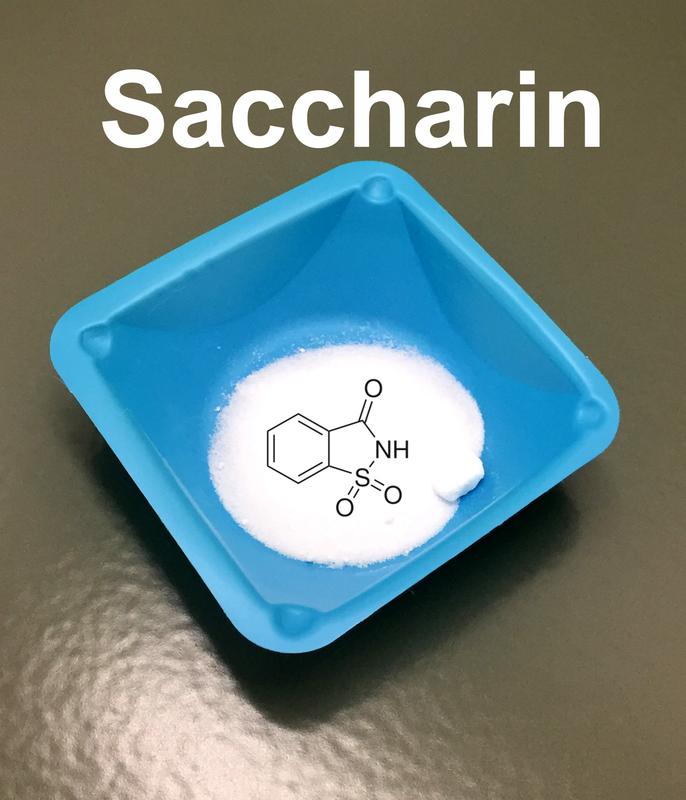

Artificial Sweetener: Saccharin
“Numerous sweeteners exhibit undesirable off-tastes, limiting their use in food products and beverages,” says lead author Maik Behrens of the German Institute of Human Nutrition Potsdam-Rehbruecke. “Our findings in this study provide us with the tools and knowledge to find ways leading to superior sweetener blends.”
High-potency sweeteners are widely used to replace energy-rich, tooth-decay-inducing sugars in food items to meet the requirements of health-conscious consumers. But in addition to stimulating sweet taste receptors, sugar substitutes also activate bitter taste receptors (known as TAS2Rs) at high concentrations, resulting in an undesired off-taste. To overcome this problem, the food industry is constantly searching for novel sugar substitutes and frequently resorts to using blends combining non-caloric sweeteners in a single formulation.
The earliest blend allowing higher sweetness levels with reduced bitter off-taste combined saccharin with cyclamate. But since this discovery 62 years ago, the mechanism by which sweetener blends become superior to single compounds has remained obscure. A clue to this mystery came when Behrens and his team discovered that some bitter compounds not only activate a subset of the 25 human bitter taste receptors, but also can inhibit different bitter taste receptors.
“Knowing that mixtures of saccharin and cyclamate exert reduced bitterness compared to the single compounds raised the question [of] whether this might be due to mutual inhibition of bitter taste receptor responses,” Behrens says.
To explore this possibility, Behrens and senior author Wolfgang Meyerhof of the German Institute of Human Nutrition Potsdam-Rehbruecke expressed various human taste receptors in human cells and tested their responses to different concentrations of saccharin and cyclamate. Using this cell-based system, they discovered that cyclamate strongly inhibits the saccharin-induced activation of two bitter taste receptors called TAS2R31 and TAS2R43. This effect occurred at concentrations where cyclamate itself does not elicit a side taste. Similarly, saccharin blocked the cyclamate-induced responses of a bitter taste receptor called TAS2R1.
“Saccharin and cyclamate belong to the oldest-known high-potency synthetic sweeteners, and we were able to discover with our cell assay completely novel features of these molecules, namely their bitter-blocking ability,” Behrens says.
For the time being, it remains unclear whether the components of other sweetener blends also show mutual inhibition of bitter taste receptors. “Once the activation and inhibition profiles of the 25 human bitter taste receptors have been investigated in great detail, it will be possible to tailor the composition of mixtures to develop novel sweetener formulations and to improve the taste of medicine,” Meyerhof says.
Funding was provided by the European Union’s Seventh Framework Programme.
Cell Chemical Biology, Behrens et al.: “Blends of Non-caloric Sweeteners Saccharin and Cyclamate Show Reduced Off-Taste due to TAS2R Bitter Receptor Inhibition” <http://www.cell.com/cell-chemical-biology/fulltext/S2451-9456(17)30278-7 DOI: 10.1016/j.chembiol.2017.08.004>
Cell Chemical Biology (@CellChemBiol), published by Cell Press, is a monthly journal publishing research and review content of exceptional interest for the chemical biology community. The journal's mission is to support and promote chemical biology and drive conversation and collaboration between chemical and life sciences. Visit: http://www.cell.com/chemistry-biology. To receive Cell Press media alerts, contact press@cell.com.
• • •
Author Contact:
Dr. Maik Behrens
German Institute of Human Nutrition Potsdam-Rehbruecke
Dept. Molecular Genetics
Arthur-Scheunert-Allee 114-116
14558 Nuthetal, Germany
phone: +49 (0)33200 88 2545
e-mail: behrens@dife.de
Prof. Dr. Wolfgang Meyerhof
German Institute of Human Nutrition Potsdam-Rehbruecke
Dept. Molecular Genetics
Arthur-Scheunert-Allee 114-116
14558 Nuthetal, Germany
phone: +49 (0)33200 88 2282
e-mail: meyerhof@dife.de
Media Contact:
Dr. Gisela Olias
Press and Public Relations Coordinator
German Institute of Human Nutrition
Potsdam-Rehbruecke (DIfE)
phone: +49 (0)33200 88-2278/-2335
e-mail: olias@dife.de
or presse@dife.de
Media Contact:
Joseph Caputo | Press Office | Cell Press
617-397-2802 | jcaputo@cell.com | press@cell.com
http://www.dife.de/forschung/abteilungen/kurzprofil.php?abt=MOGE&lang=en Department of Molecular Genetics at the German Intistute of Human Nutrition














